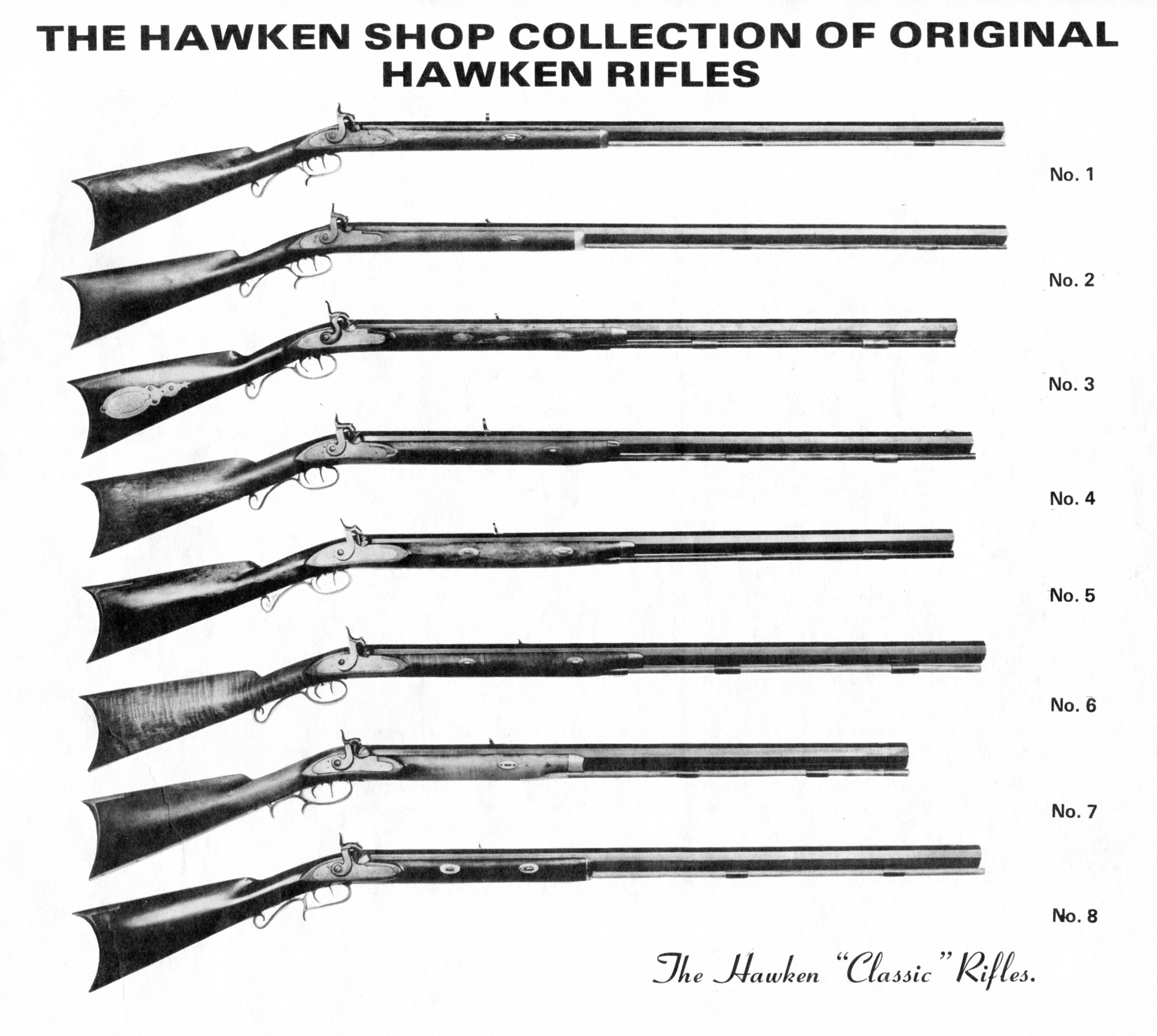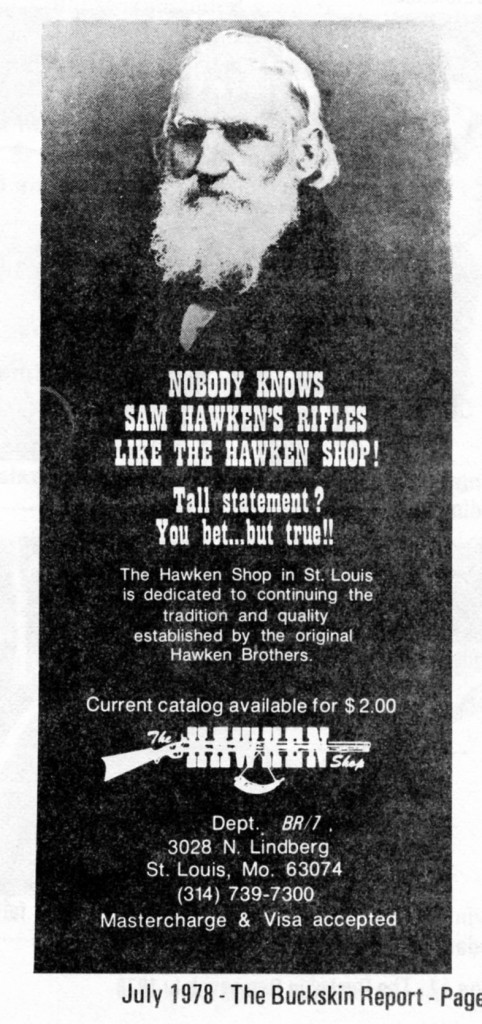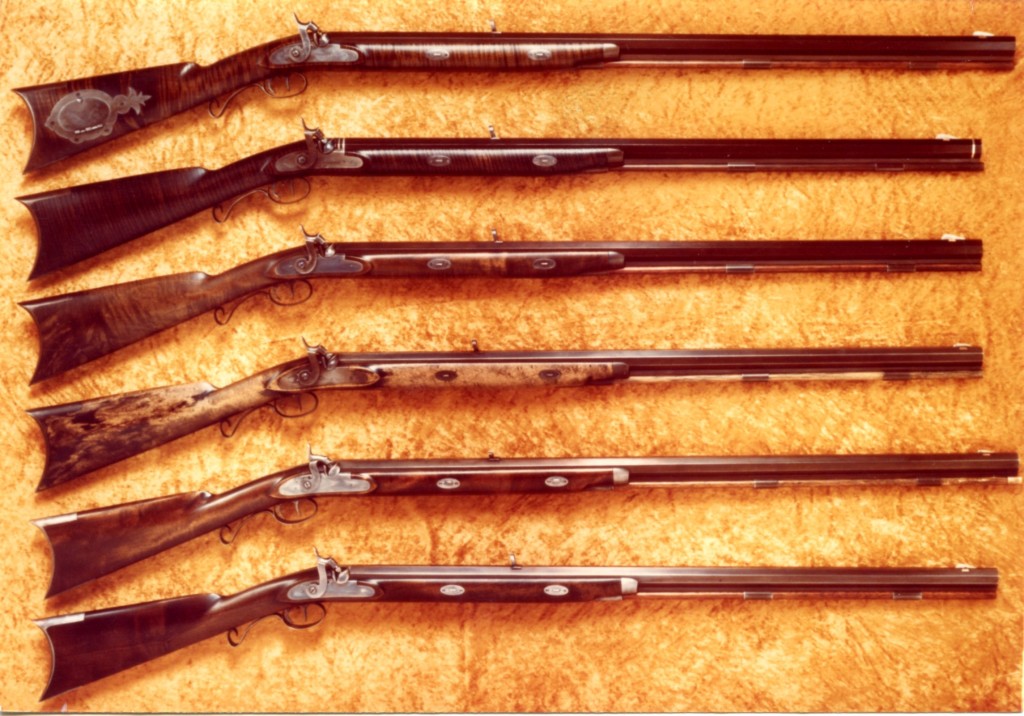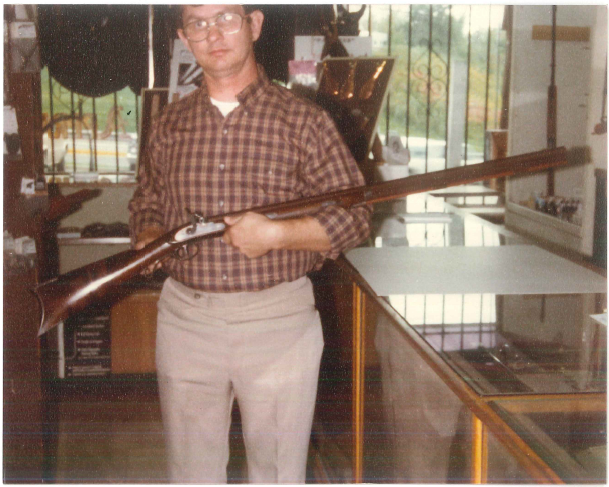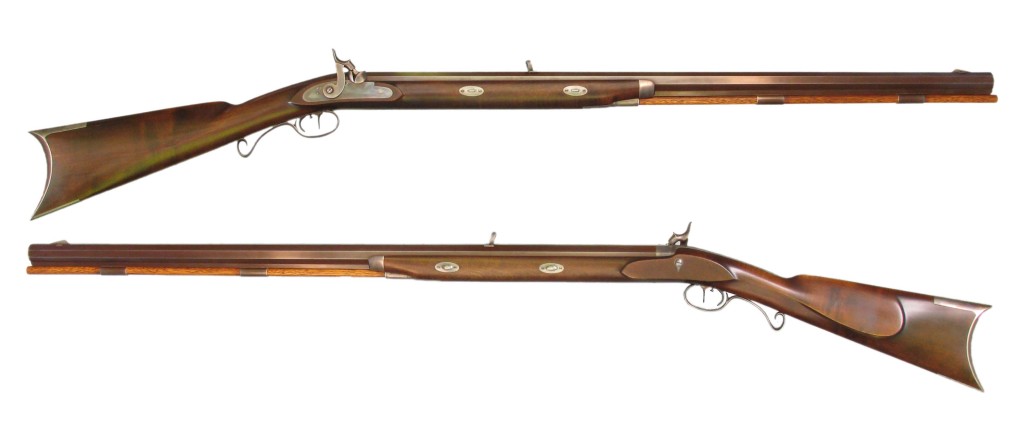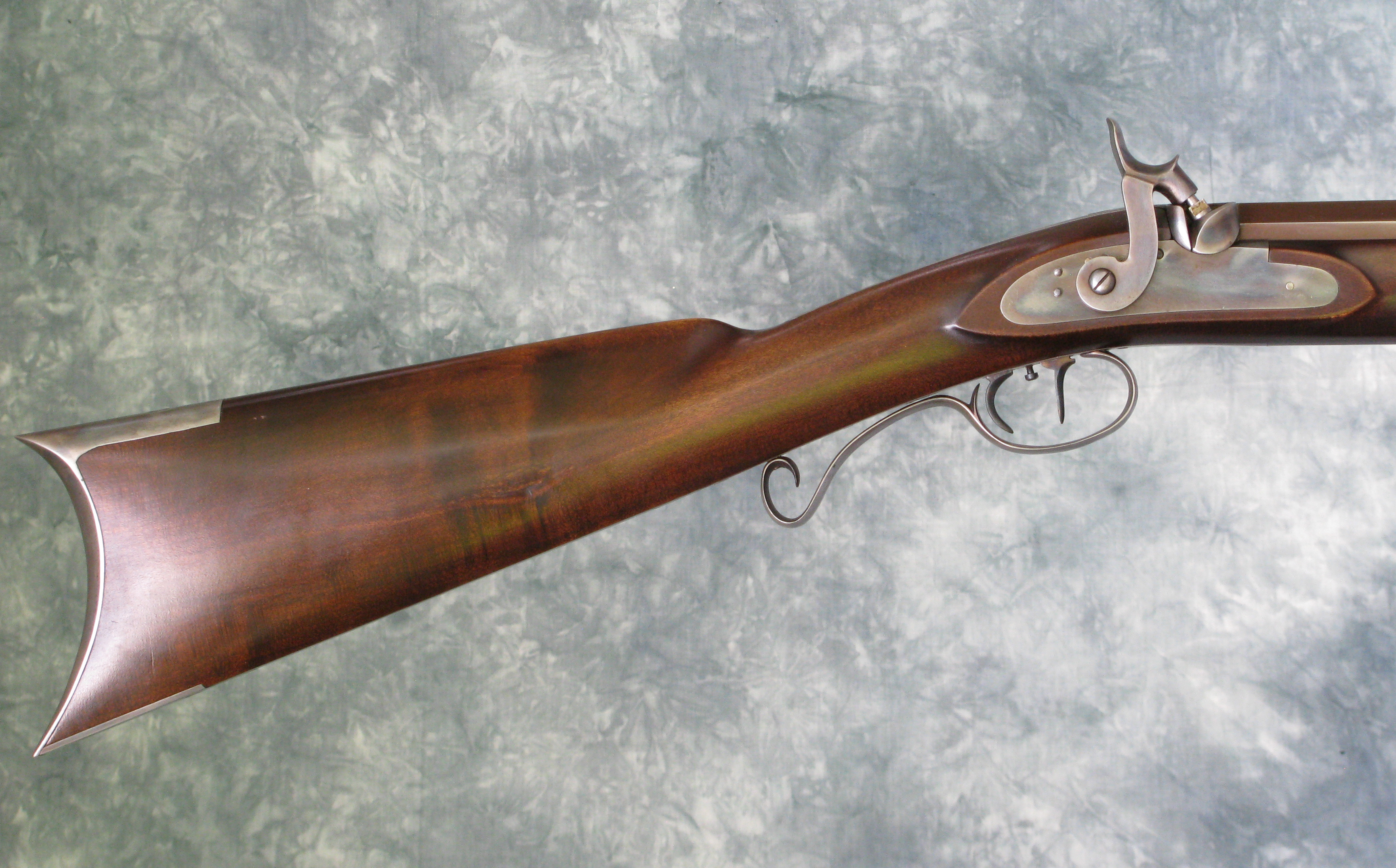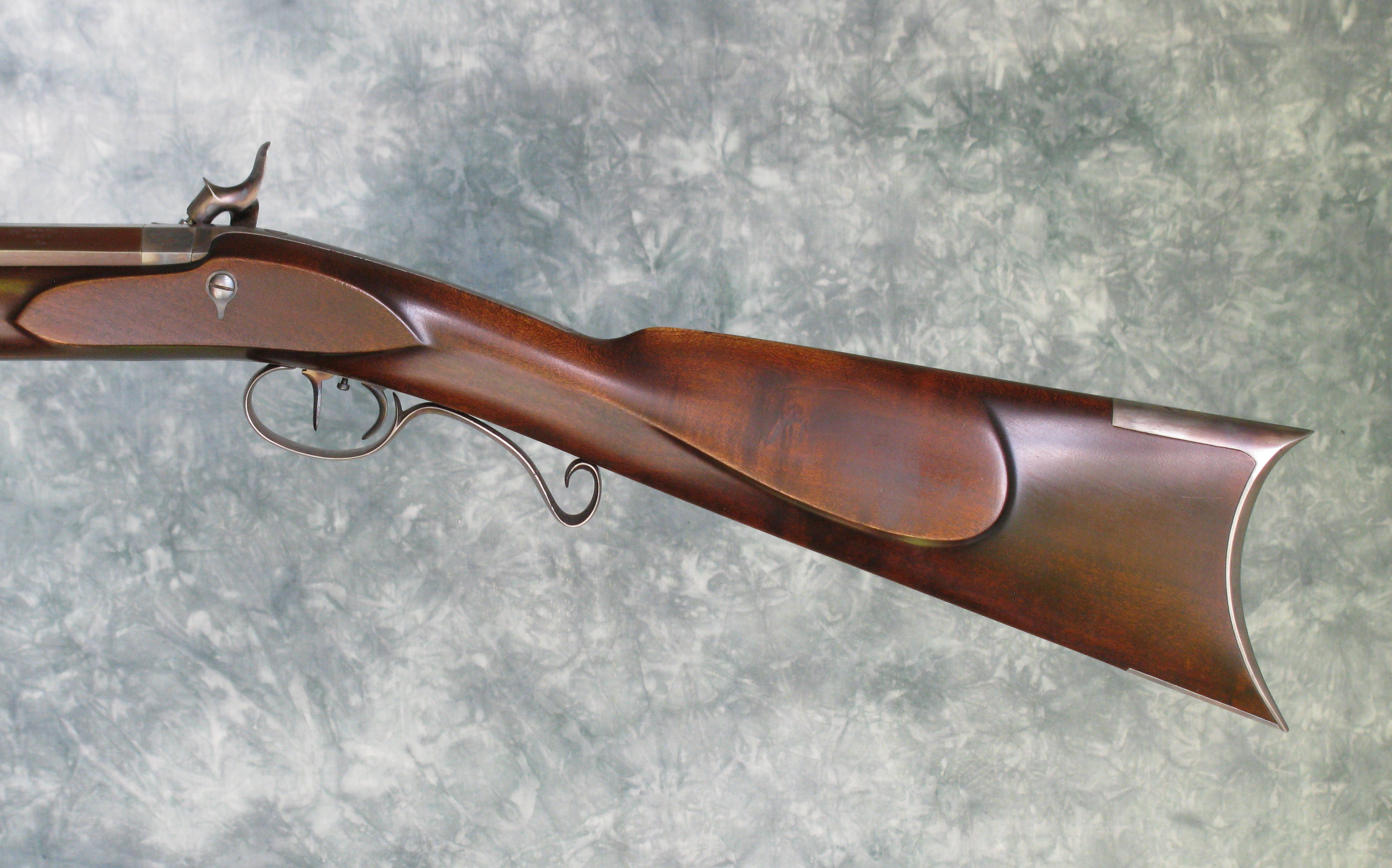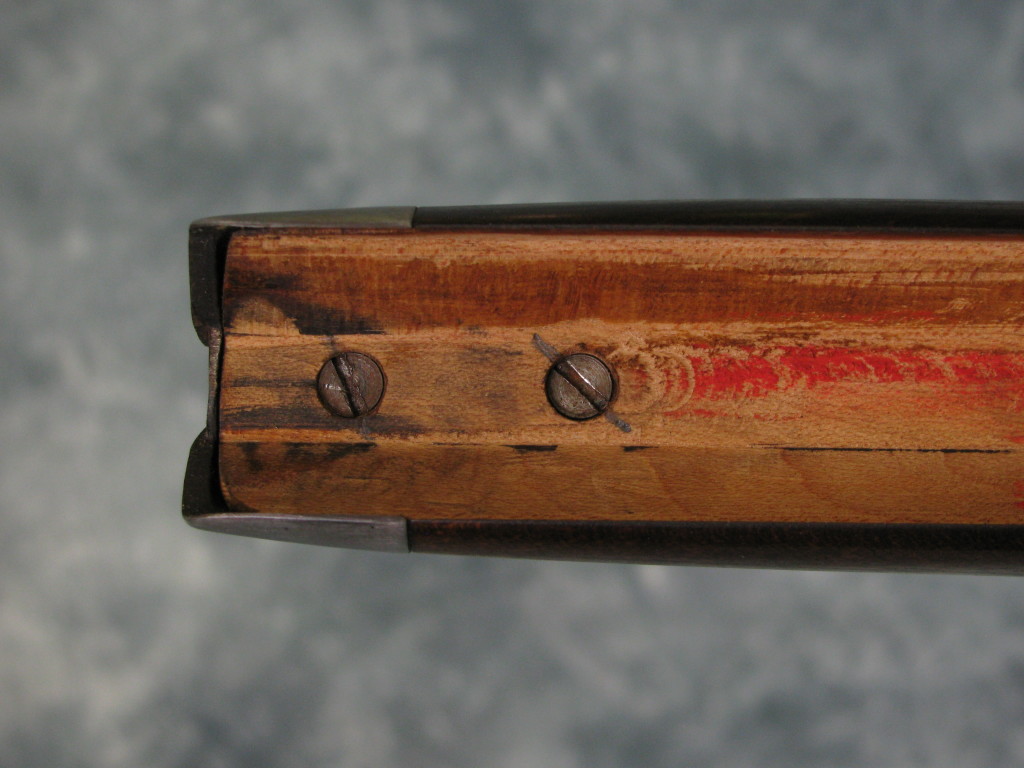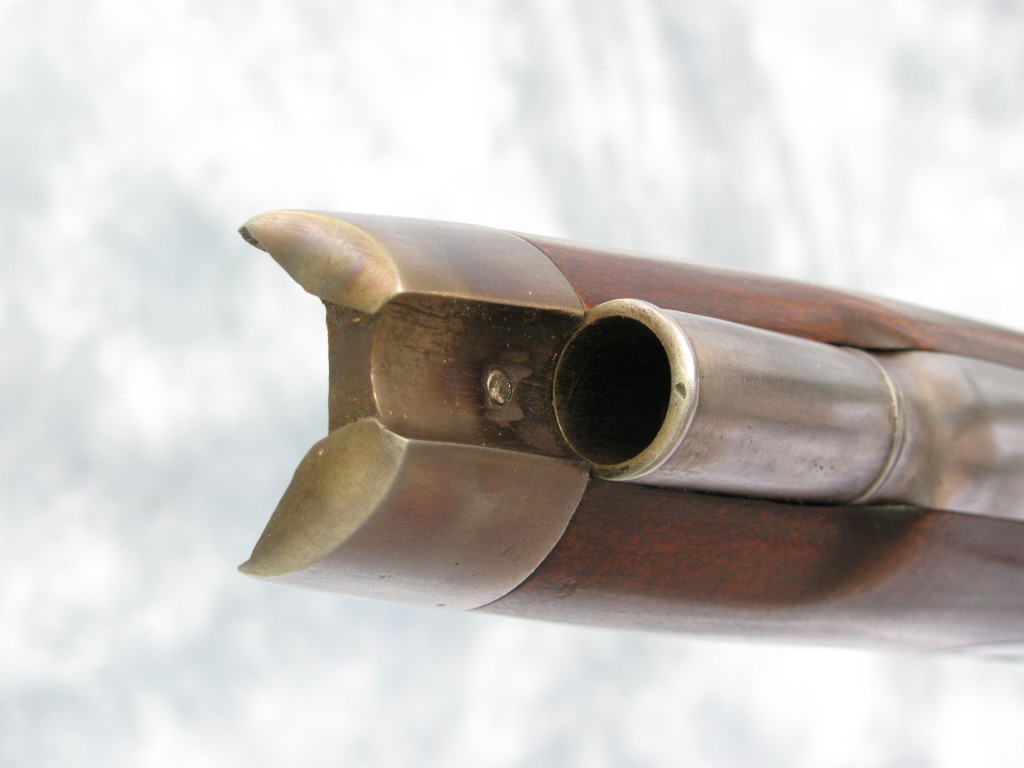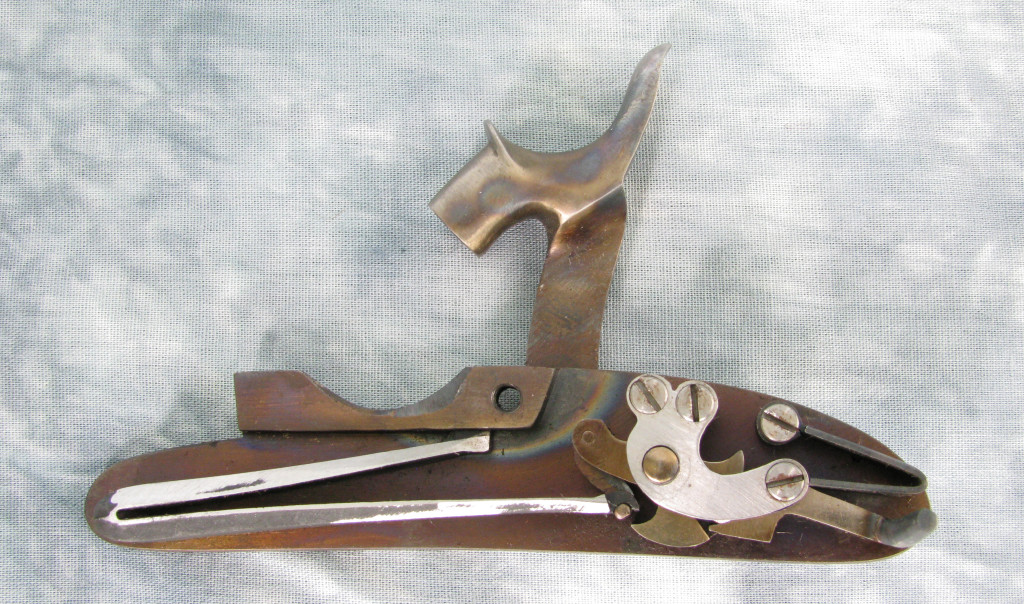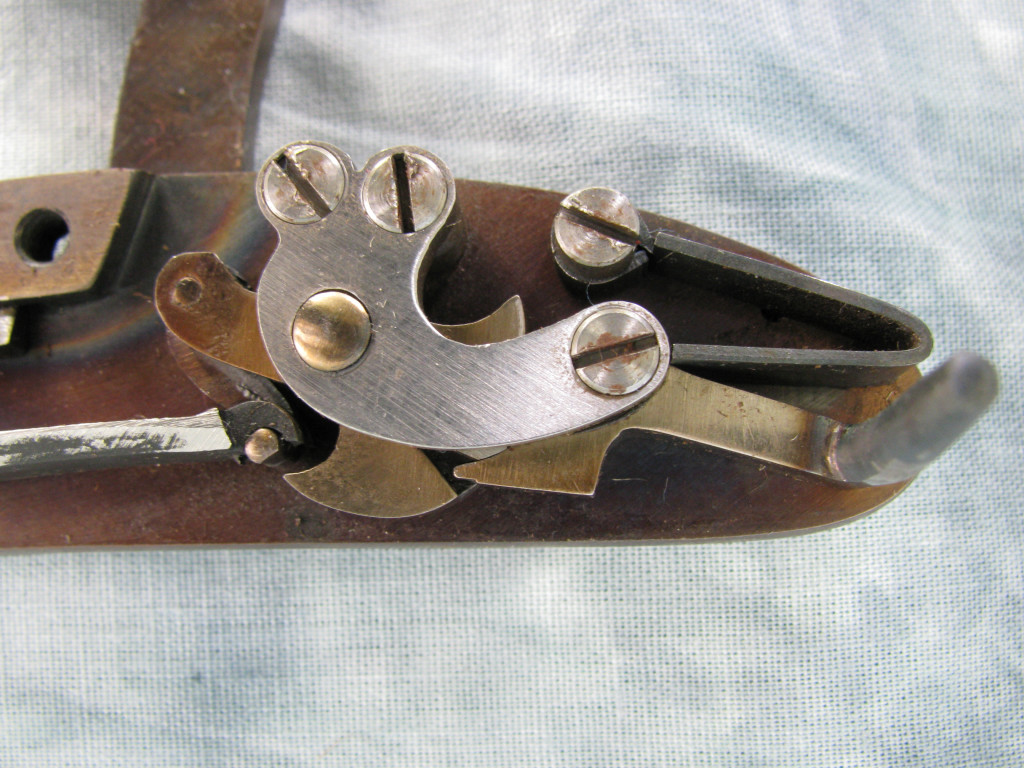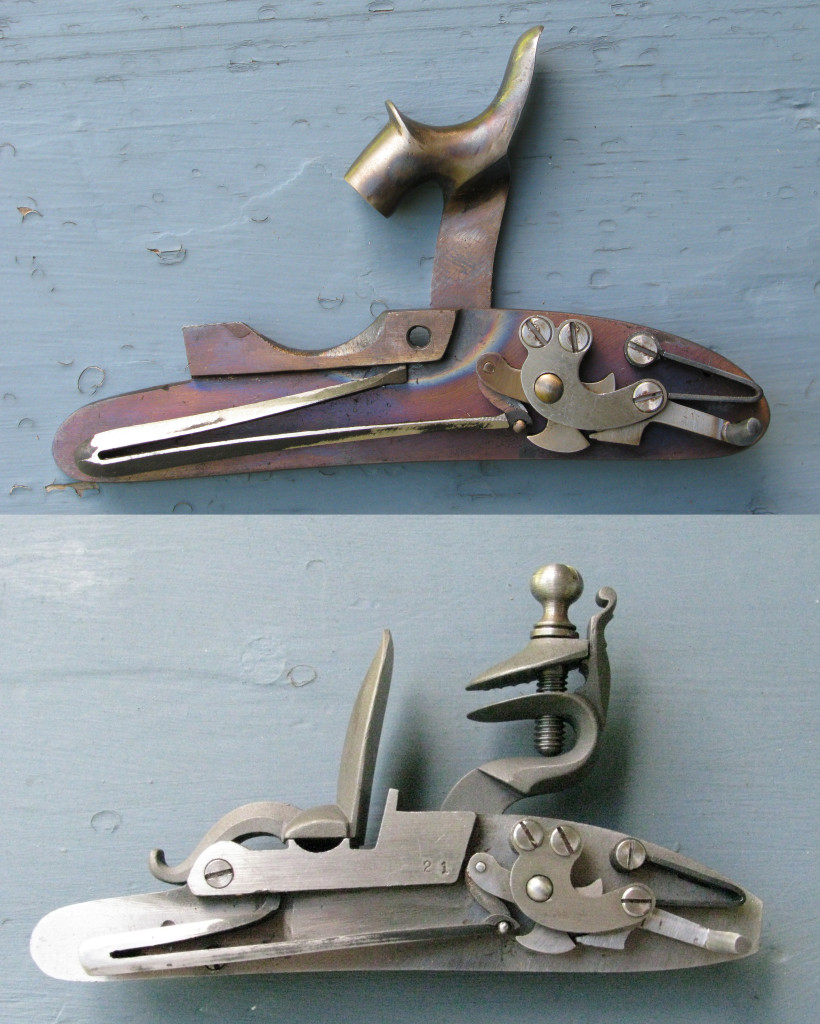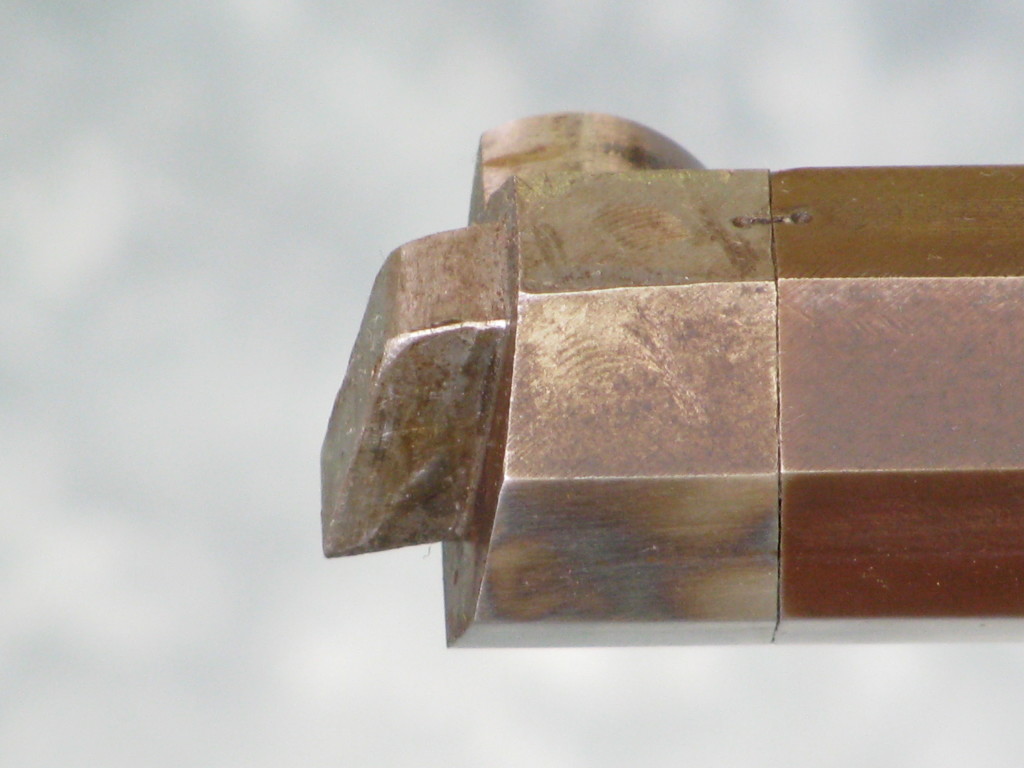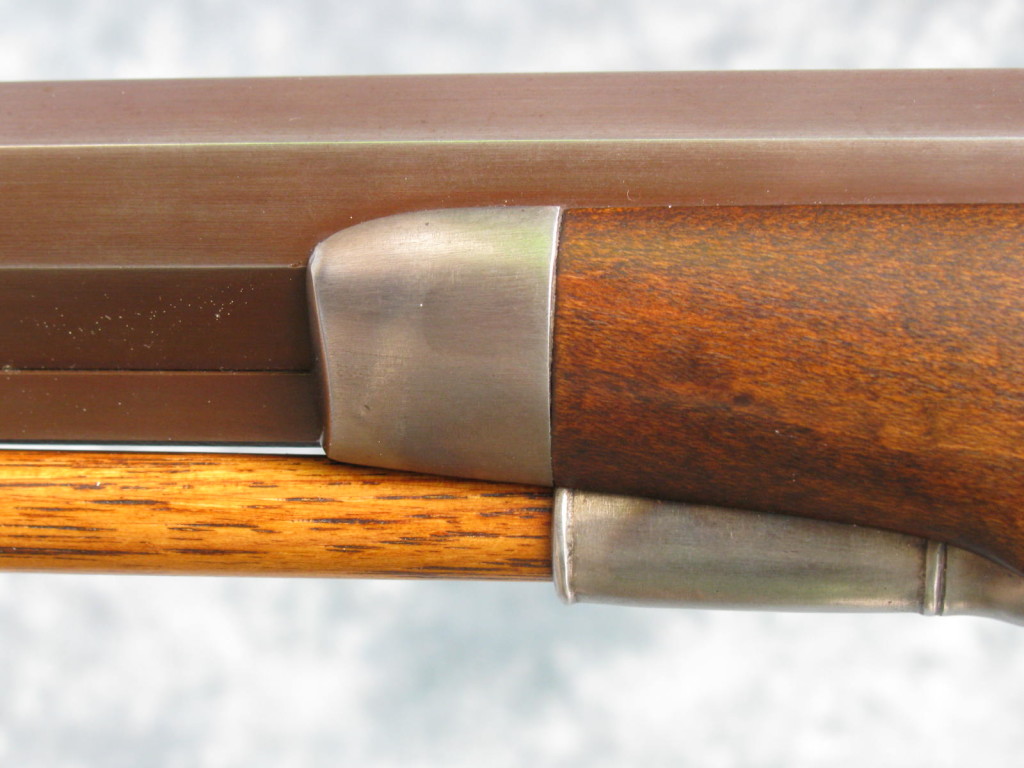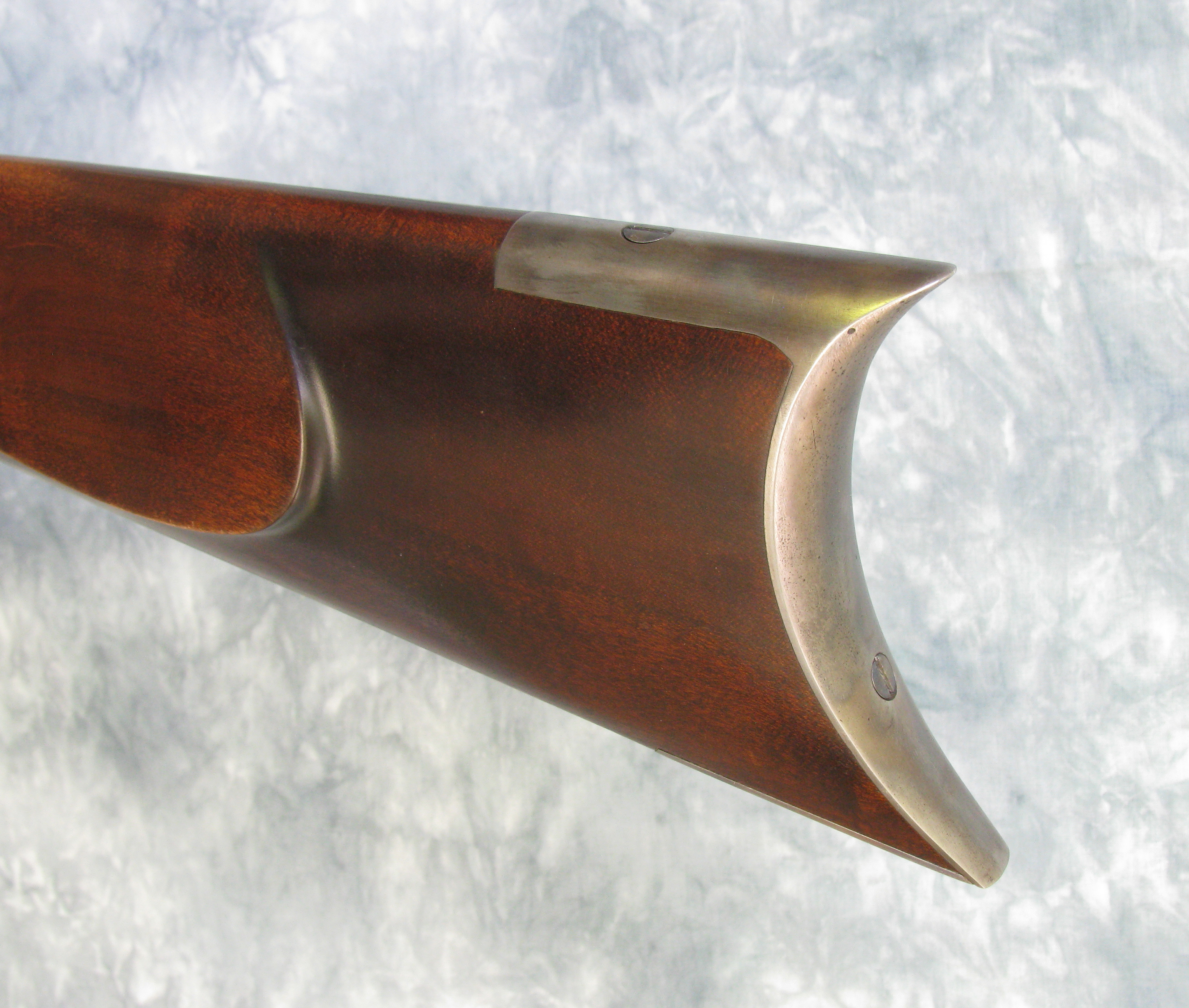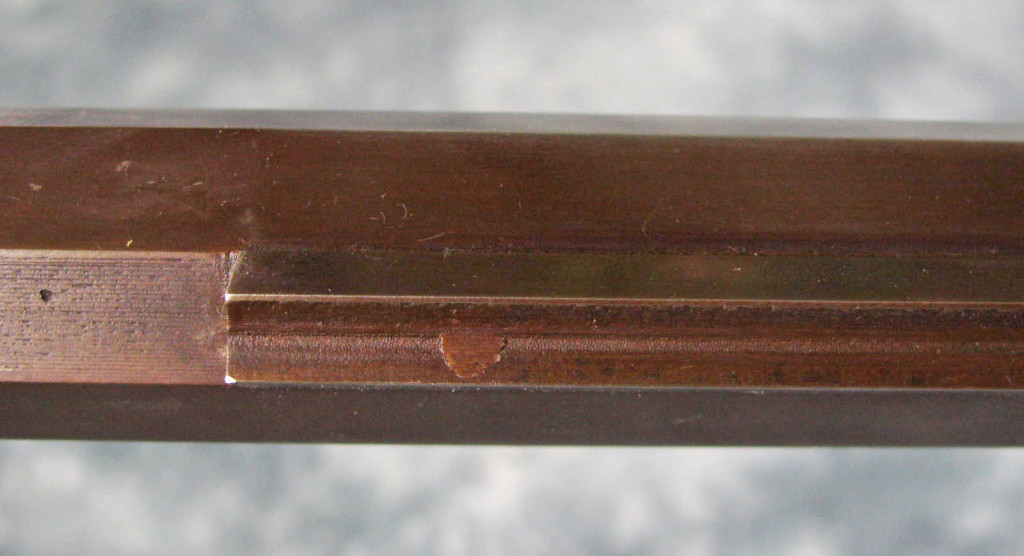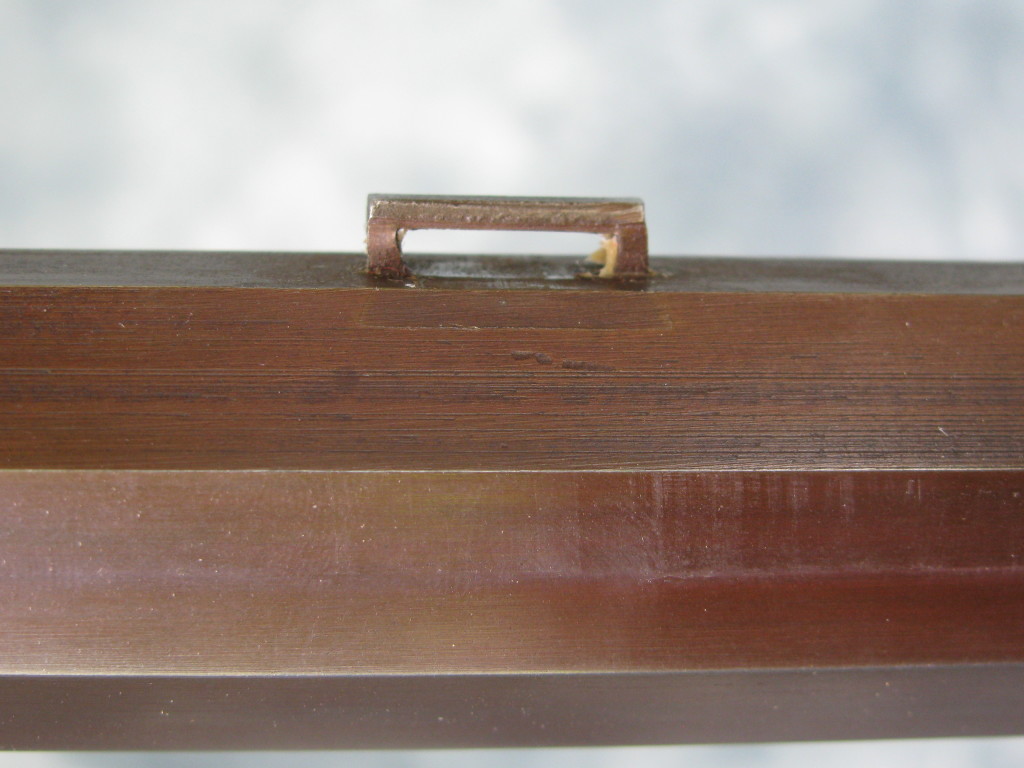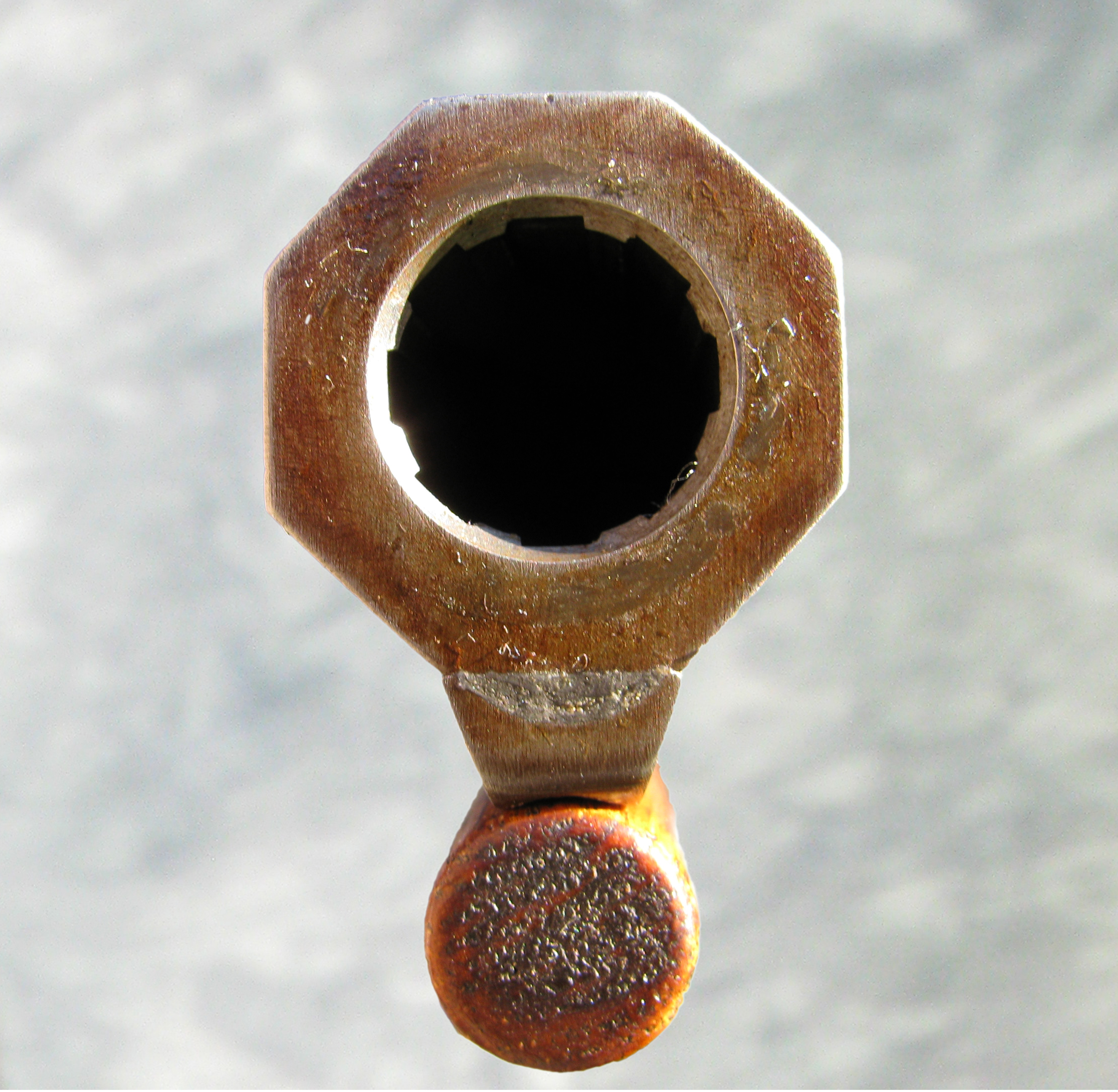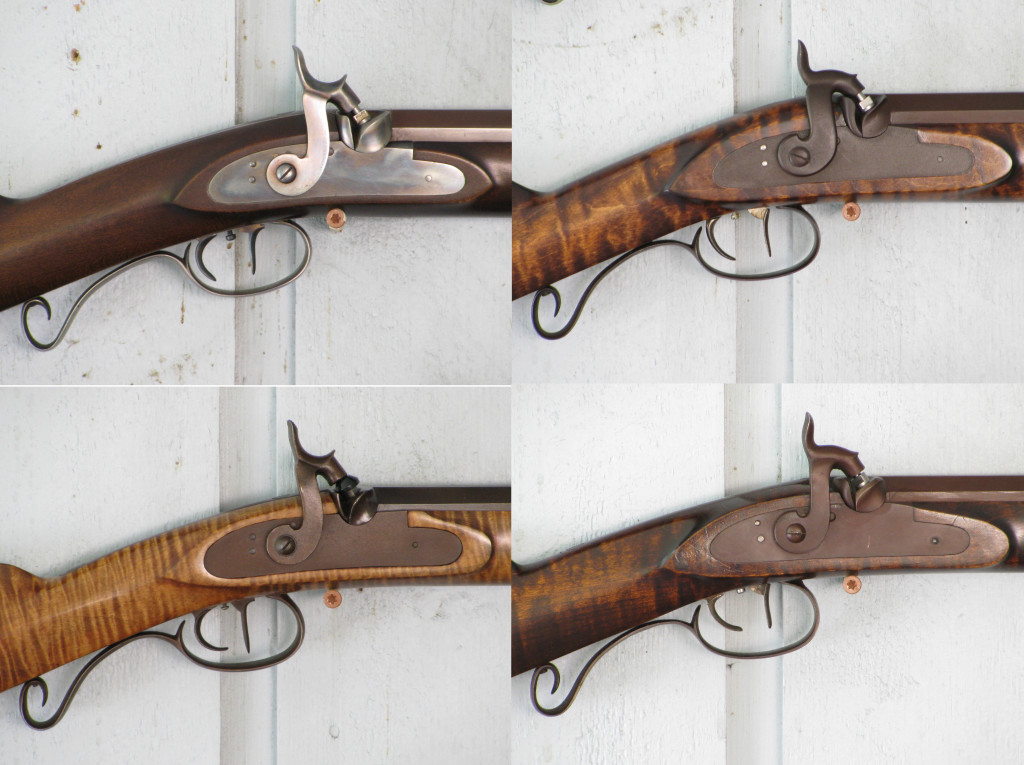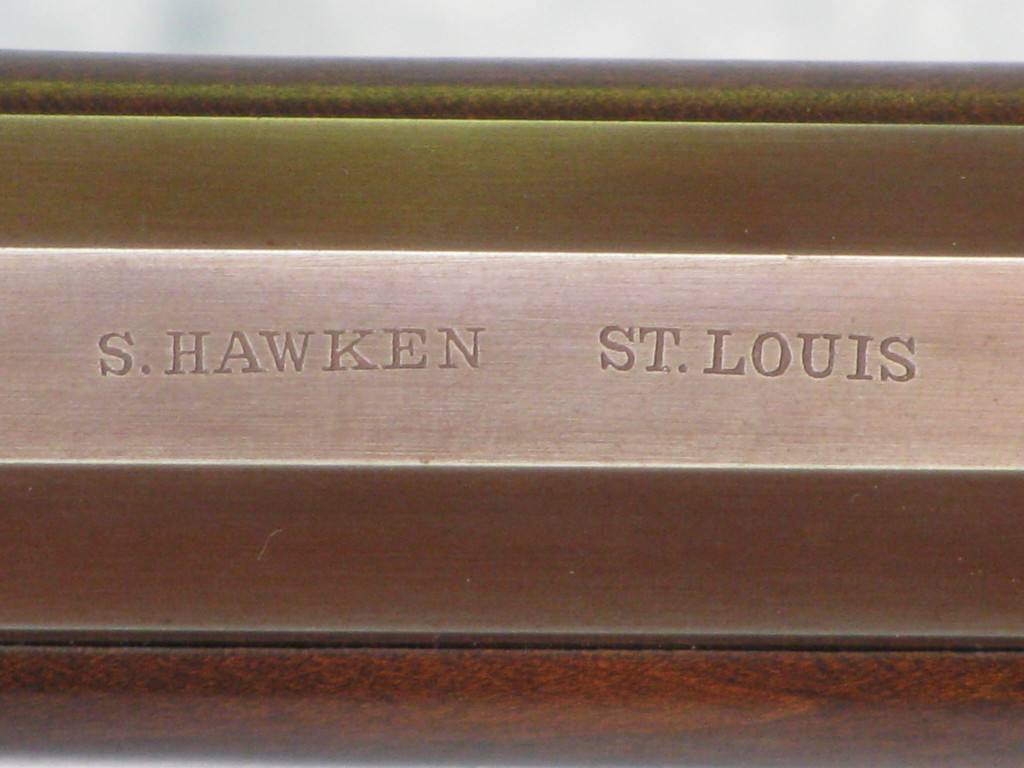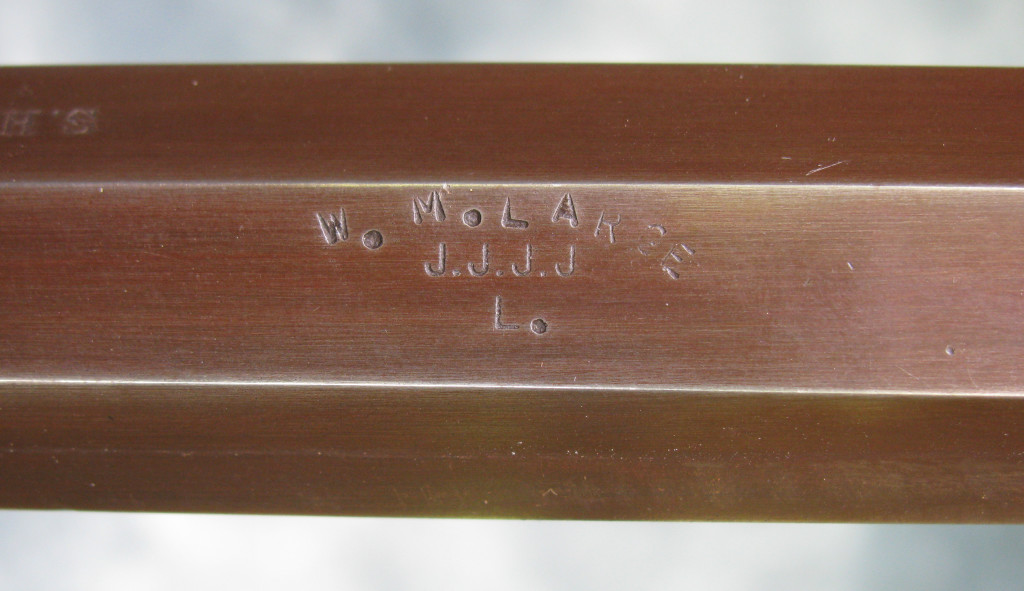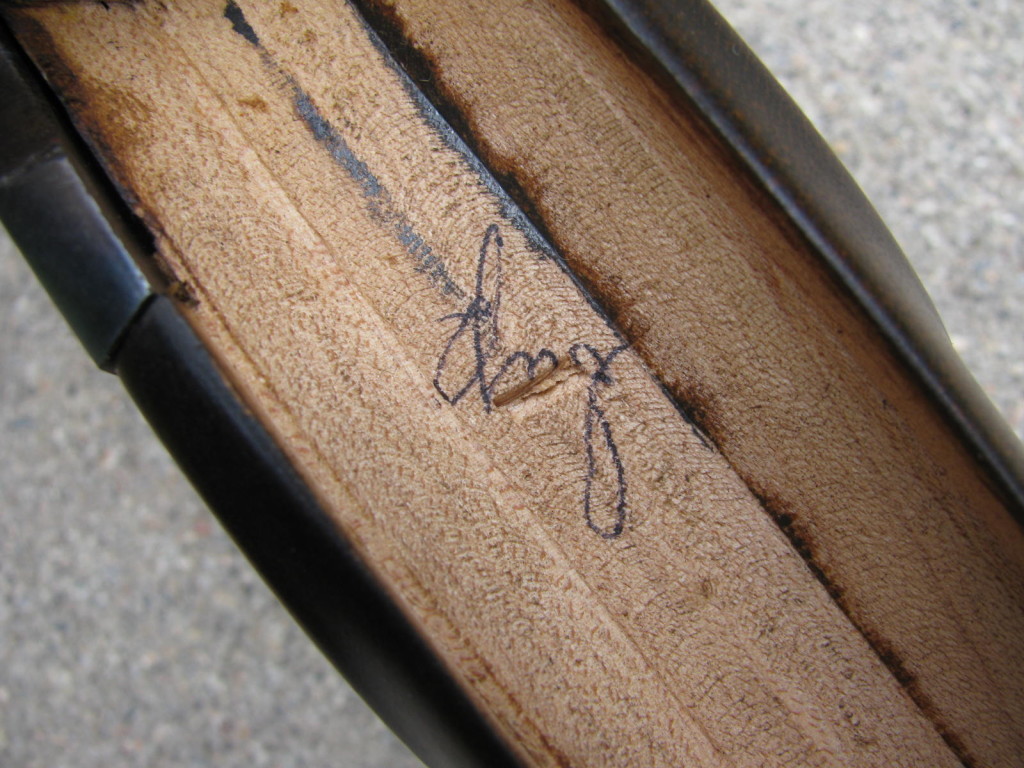COMPANY HISTORY
Art Ressel was an early student of the Hawken rifle. In the 1960’s, he was able to acquire much of the shop tools and equipment left over from the Hawken-Gemmer gunshop.
Art was also a firearms collector and antique appraiser and had collected a number of original Hawken rifles before their prices shot up dramatically in the 70’s.
Rifle No. 5 in the photograph above is Hawken Shop Prototype No. 1 made in 1978. The other rifles are originals.
He apparently opened The Hawken Shop sometime around 1971 as a typical muzzleloader shop. It was a while before he started offering an authentic Hawken rifle. The first mention I could find in the black powder magazines of his Hawken parts was in the July 1977 issue of The Buckskin Report. That issue had an article about contemporary St. Louis gunsmiths that were building custom Hawken rifles and listed Art Ressel as the best known of the group. This product report on his Hawken parts followed that article.
Note that Ressel was still working on his Hawken breech & tang and lock when this issue came out. Also, shown in this picture is a comparison of the new cast part and the corresponding part from an original Hawken rifle from which it was cast. This was the first effort to make direct castings from original Hawken rifles that could be used to build a coherent replica of an actual Hawken rifle. It is my understanding that the parts that were used for the castings were from two or more of the originals in Ressel’s collection, but they still integrate together well.
The earliest advertisement I could find for Art Ressel’s Hawken Shop is shown above from the September 1977 issue of The Buckskin Report.
He continued to advertise periodically in magazines as he expanded his product line.
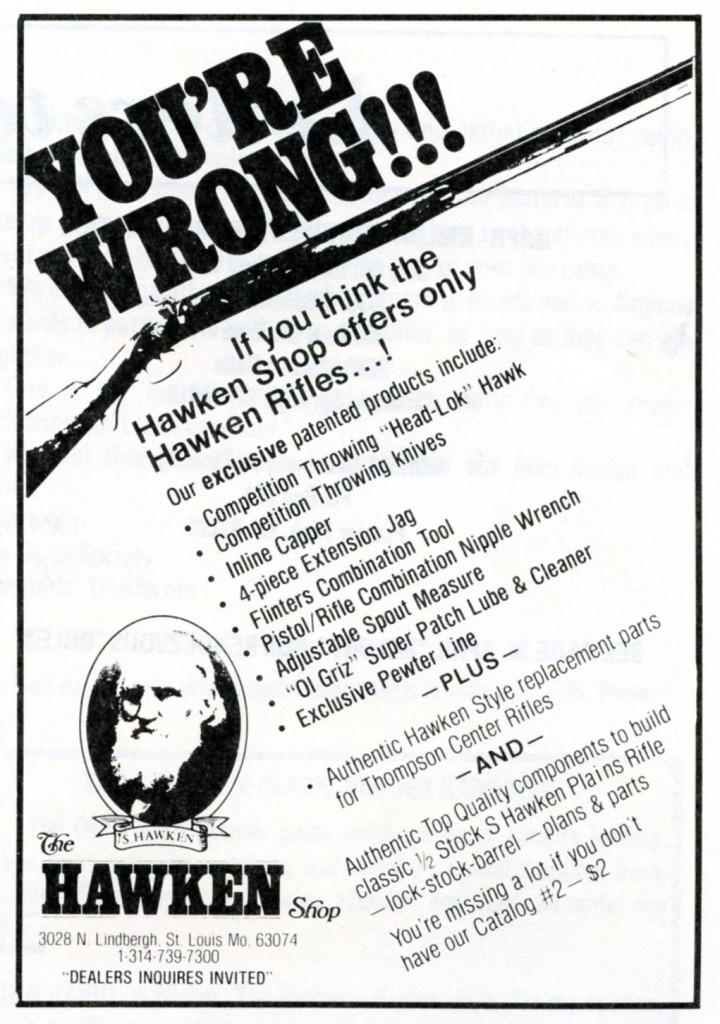
By the end of 1980, he was advertising that The Hawken Shop offered a complete parts set for a S. Hawken rifle.
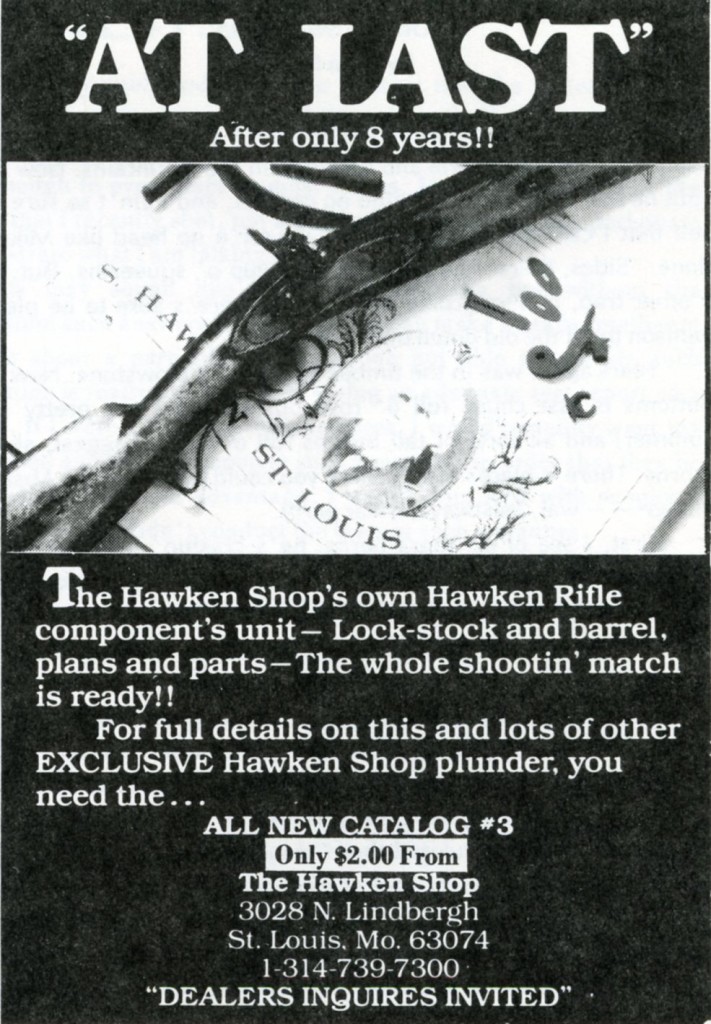
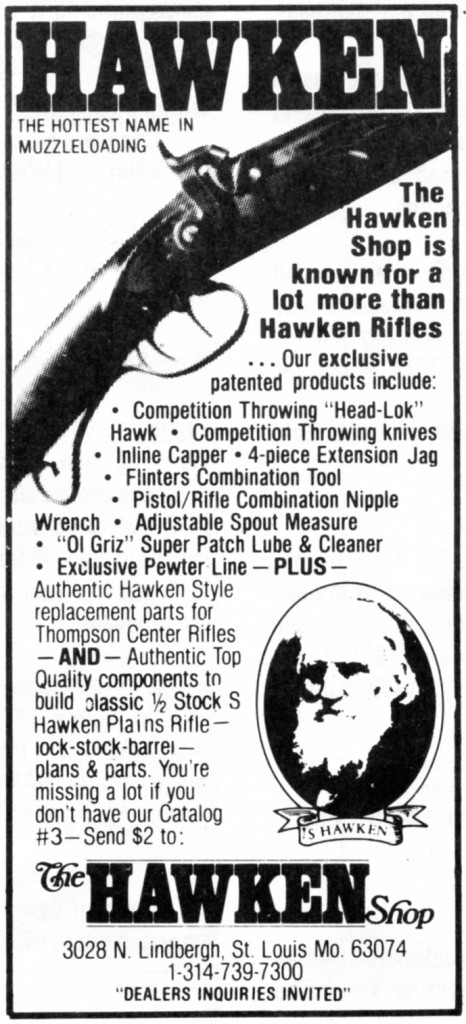
Through the early 1980’s, The Hawken Shop continued to add new products to their list of items directed at the muzzleloader enthusiast.
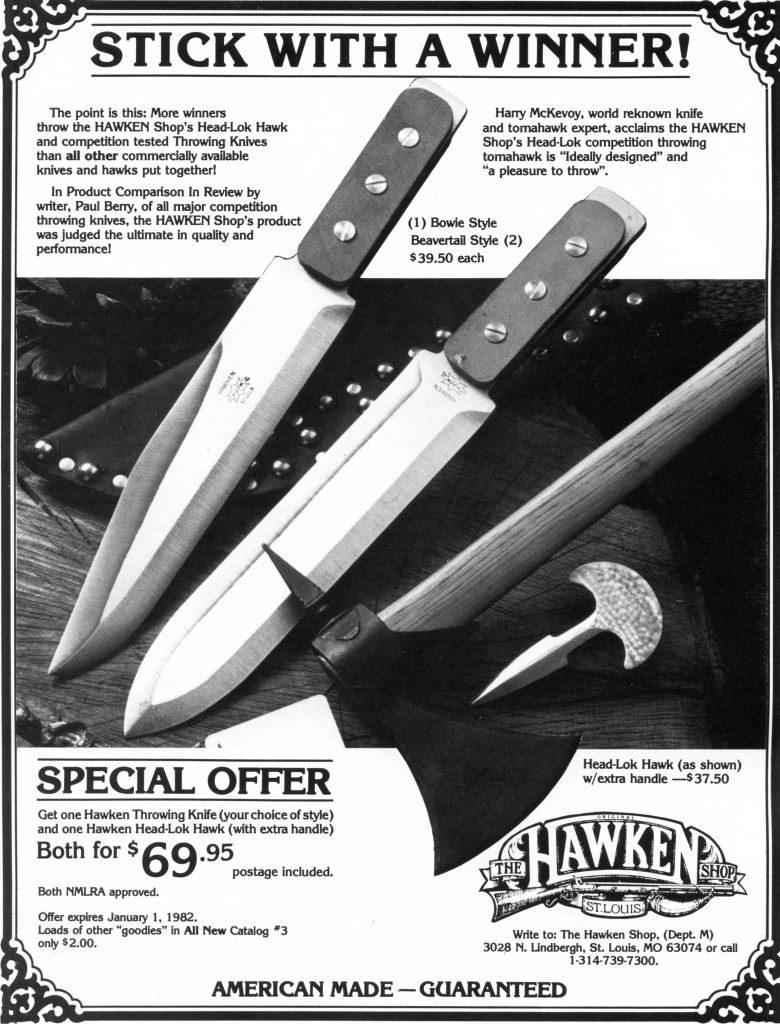
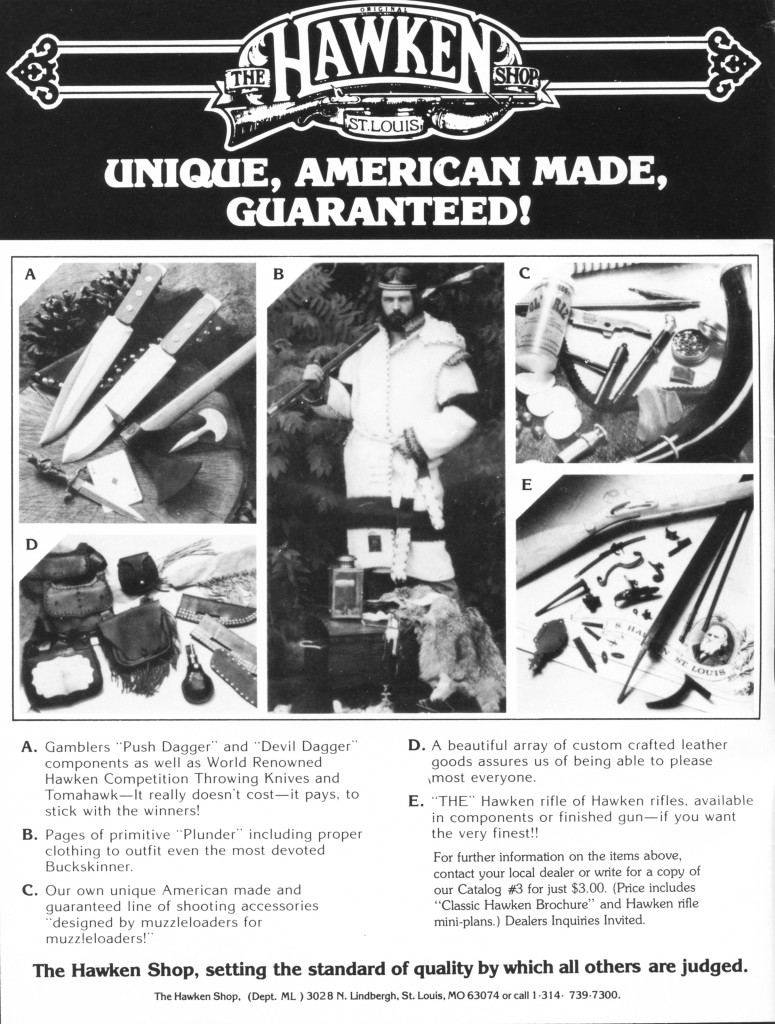
The Hawken Shop didn’t advertise much after 1982. I only found one more ad in the Jan-Feb 1984 issue of Muzzleloader magazine post-1982.
The Book of Buckskinning III, copyrighted in 1985, had a chapter written by David Wright on contemporary gun makers that included write-up on Art Ressel and The Hawken Shop on pages 51 and 52. That is the last reference I could find on The Hawken Shop as a going concern. Then, the Jan-Feb 1987 issue of Muzzleloader had a notice from Art Ressel that he was putting The Hawken Shop up for sale.
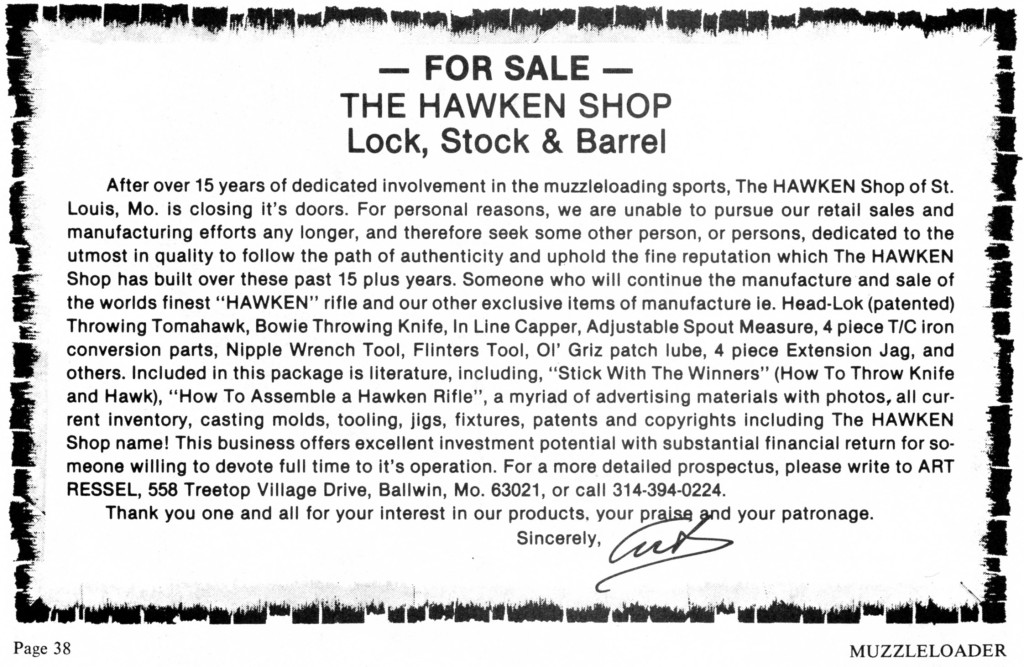
Greg Roberts and Claudette Greene purchased “The Hawken Shop” from Art Ressel in December of 1990 and relocated the entire shop to their family owned business in Oak Harbor, Washington.
THE RIFLE
I call your attention to item E in the ad above from the Mar-Apr 1982 issue of Muzzleloader which says, “THE Hawken rifle of Hawken rifles, available in components or finished gun—if you want the very finest.” Art would occasionally contract out to some custom gunsmiths to build a finished rifle using his parts. He often had several of these finished rifles available in the Shop for sale, and also to show customers what could be made from his parts. By 1985, he apparently quit offering finished rifles. The Book of Buckskinning III piece said, “Though in the past completed guns have been built on order, presently the Hawken Shop offers the S Hawken half stock rifle in kit or component form only.”
The Oak Harbor Hawken Shop website says that, “less than 300 Hawken’s were produced during this period.” It’s not clear if they are talking about finished rifles or kits. Considering that the finished rifles were truly custom guns and sold for twice the amount that a GRRW half stock Hawken sold for, I doubt that Ressel had that many built. The period that he sold finished rifles appears to have been less than five years, late 1980 to sometime before 1985. Assuming a generous number, on the order of 20 to 25 custom rifles built per year, it would total less than 100 finished rifles sold.
Some of the custom builders he used may have included:
- Keith Neubauer
- Doug Scott
- Joe Corley
- Bevins or Blevins
- Bob Darnstatter
Keith Neubauer and Doug Scott were pictured in The Hawken Shop Catalog No. 2 on page 34.
This photograph shows some of the reproduction Hawken rifles that were on display in the shop in 1981.
In personal communications with Joe Corley, he identified the third rifle down as one he had built.
The bottom rifle in the picture above was purchased by the gentleman in the picture below in 1981.
The owner wrote this on the back of the photo.
 I acquired the rifle in June of 2014 when the owner’s son put the rifle up for sale on Track of the Wolf.
I acquired the rifle in June of 2014 when the owner’s son put the rifle up for sale on Track of the Wolf.
The specifics on the rifle are:
W. M. Large barrel, .54 caliber, 34” long
Nominal 1⅛” to 1” straight taper (actual dimensions 1.097” at breech and 0.978” at muzzle)
Lock (with Ron Long internals) and all furniture from The Hawken Shop
Total length is 51⅛”
Length of pull is 1315⁄₁₆”
Weight is 10 lbs
Height from top of barrel to bottom of forearm just behind rear sight is 1.99”
Width of forearm just behind rear sight is 1.52”
Height of wrist is 1.70” at mid-wrist
Width of wrist is 1.30” at mid-wrist
Drop at heel is 3”
Ramrod is tapered ½” to ⅜” at brass tip
ID of the upper pipes are ½”, ID of the entry pipe is 7/16” at the opening, but tapers towards the back end with just enough clearance for the tapered rod.
The stock is plain hard maple, stained dark, and finished with a varnish like finish. There is a little figure in the butt stock, but it’s not uniform.
In the pictures below, the triggers are unset. Notice how closely the back of the trigger bow fits around the rear trigger. The fit is even closer in the set position. You can’t get this fit with Ron Long’s triggers and the commercially available Hawken guards without extensive bending or forging of the guard. The Hawken Shop trigger set and guard is a cohesive unit. This is because the triggers and trigger guard were copied from an original in Art Ressel’s collection. The trigger plate is 1½” shorter at the rear than the Ron Long trigger plate.
The barrel is the only browned metal on the rifle. All the other metal parts appear to be color case hardened (more on this later), with some parts showing signs of wear where the finish is almost back to bright metal.
There is no extra wood anywhere on this rifle. The forearm is nicely rounded. The lock panels have a minimum amount of wood around the lock. They also taper from front to back. The wrist has been slimmed down just right.
It’s obvious that the builder had access to original Hawken rifles and followed their lines faithfully.
The nose cap and the entry pipe are held on by screws, following the original rifle. GRRW used this method on their Bridger Commemorative Hawken and the late S. Hawken rifles they built after the Commemorative project.
It is interesting that the builder of the Hawken Shop rifle indexed the screw slots with pencil marks.
The internals don’t quite match the internals in the photo of The Hawken Shop Catalog #2. The bridle is similar to Roller’s while the mainspring is similar to Long’s. I can’t tell much about the tumbler in the Roller lock in the scan of the catalog but the one in the subject rifle definitely isn’t a Long tumbler. The internals are clearly not Schillinger’s, either.
It turns out, I was using the wrong catalog for comparison. Their Catalog No. 3, which came out in in the later part of 1980, had this photo and description on page 8.
Comparing the lock in Catalog #3 to the one on my gun.
There’s a little lens distortion in my picture, but I believe both locks clearly have the same internals.
The Hawken Shop issued Catalog #3 in the later part of 1980, so it would have been current when the subject rifle was purchased in 1981.
The Hawken Shop lock plate is a little shorter (by more than 1/4″) than the standard Ron Long percussion lock. Long switched to using the internals from his late English flintlock in Art Ressel’s Hawken lock. Here is a comparison of the two locks showing that they have the same internals (except mainspring which is from Long’s percussion lock).
The rifle was advertised as having color case harden lock, breech, and furniture, but on close inspection after receiving the rifle, I believe it is faux color case hardening that was skillfully done with a torch.
You can see this in the pictures of the inside of the lock plate above. It doesn’t have the mottled look of the outside of the plate. Except for the area just behind the plate bolster, the inside of the plate wasn’t heated beyond the straw/brown color.
There is no color on the hidden flats of the breech plug.
The trigger plate, trigger guard, butt plate, nose cap, and wedge escutcheons appear to have faux color case hardening, but the butt plate, nose cap, and wedge escutcheons color is faint as if partially worn off. The edges of the barrel flats also appear to be slightly worn.
I had assumed this was handling wear that had occurred over the 30+ years since the rifle was purchased, but after I received the photos from the seller that had been taken by his mother and father in Art’s shop (photos above), I realized that the rifle was originally finished with this wear pattern.
I met Richard Wesenburg of St. Louis at the 2014 CLA show. Richard knew Art Ressel and many of the St. Louis muzzleloader builders of the 70’s and 80’s. When I was describing the rifle to Wesenburg, he said that Keith Neubauer was the best of the custom rifle builders that Ressel used for his “built to order” rifles at creating the faux color case hardening and faux wear patterns. He said Keith was not only well known for building contemporary muzzleloaders, but also an expert at restoring antique guns.
A few other details on the rifle—the underrib is riveted on the barrel rather than held on with screws or held on with screws that have had the countersunk heads partially filed off to remove the screw slots.
The under lugs for the barrel wedges are dovetailed in place.
Notice that only the exposed flats have been draw filed to remove the milling marks. Something that Keith would have observed on the antique rifles he restored.
And of course, the front of the rib has the half-moon soft solder common on original Hawken rifles.
One of my pet peeves about replica Hawken rifles is the shape of the trigger guard, specifically the shape of the scroll at the rear of the guard. The Hawken Shop trigger guard, having been cast from an original, is the only 1970’s vintage contemporary Hawken rifle that had the right shape.
The Hawken Shop Hawken guard (upper left) is compared to two GRRW Hawken rifles (on the right) and an Ozark Mountain Arms rifle (on the lower left) in the photo below. You will notice that the back of the guard bow doesn’t fit the rear trigger as well, and the oval of the scroll at the end of the guard is angled too vertically on the GRRW and OMA rifles. The oval of the scroll needs to be almost perpendicular to the line of the bottom of the butt stock like on the Hawken Shop rifle.
There are no makers marks or signatures anywhere on the rifle. The only stamps are the “S. Hawken, St. Louis” on the top flat behind the rear sight and the “W. M. Large” over “J.J.J.J” and “L” on the left oblique flat near the breech.
The only other marks on the rifle were some hand written letters inside the barrel channel of the stock. However, I don’t know the significance, if any, of these letters.
There is no way to know for sure who built this rifle for Ressel, but the faux color on the metal parts and the slight aging of the rifle would support attributing it to Keith Neubauer.

Technically, it may not be correct to consider Art Ressel’s The Hawken Shop as a competitor to GRRW. The rifles that Art had made and sold through the shop were, in all respects, custom rifles. He did not have a factory operation building rifles. It probably isn’t fair to compare a custom rifle to a semi-custom rifle. The Hawken Shop did sell kits and individual components, but they were expensive. The Hawken Shop kit cost close to $400 in 1980. That compares to about $280 for a half stock Hawken kit from GRRW or Track of the Wolf.
I’ve included the Hawken Shop Hawken in the discussion to point out that the only way to obtain a more accurate late S. Hawken replica than GRRW’s version was to buy a custom build.

The improvement in accuracy of the Hawken Shop Hawken over the GRRW Hawken is primarily in the trigger guard shape and fit, and marginally, in the butt plate. Otherwise, the GRRW fit and finish is as good as some of the best custom builders of the time. The price difference seems a lot more noticeable than the accuracy difference as the Hawken Shop rifle cost $1,500 while the GRRW rifle cost $800-850.
Return to The Heyday Of The Hawken
Return to GRRW’s Competition


